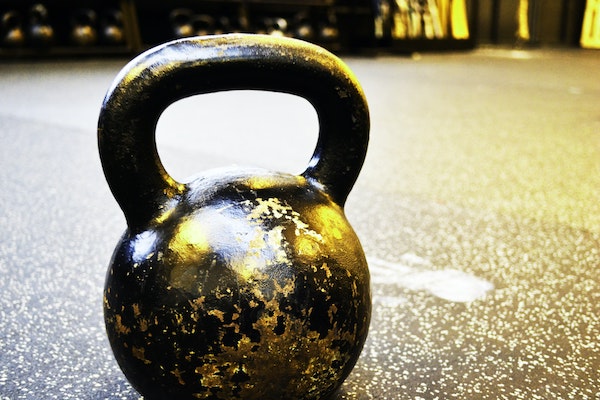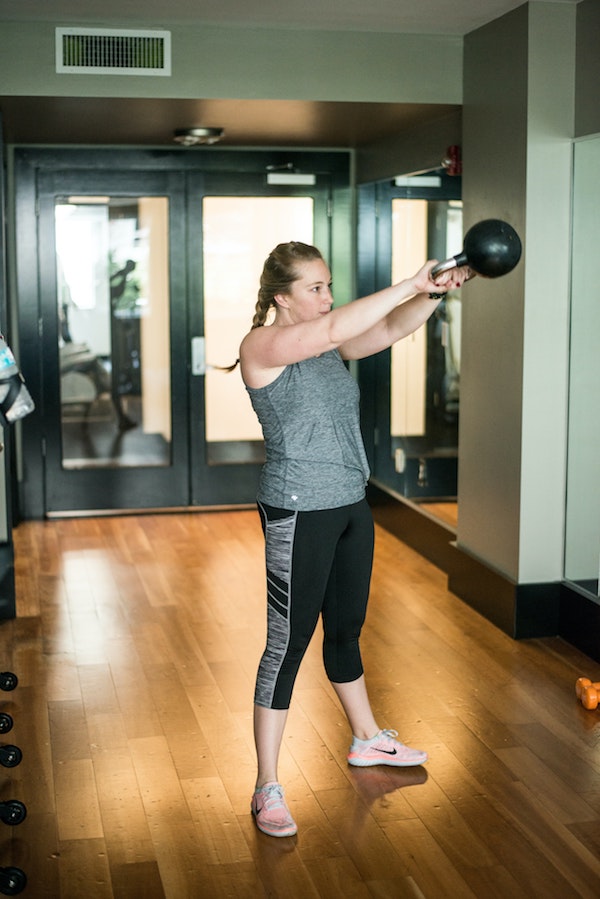
Move over, dumbbells.
Over the past couple of years, kettlebells have exploded in popularity both inside the gym and out.
Kettlebells are cast iron weights with a handle attached at the top and a round, weighted bottom. You may have seen people in the gym using them for explosive, athletic movements.
But you can also use kettlebells for more traditional weight training exercises like bicep curls and lateral raises to make them more challenging.
If you’re looking to mix up your workout and take on an extra challenge, kettlebells may be right for you. To help you decide if you should get a set or stick to dumbbells, here are some of the pros and cons of kettlebell workouts.
Because kettlebells have an unbalanced shape, they’re a little harder to lift than regular dumbbells. Your muscles not only have to lift the kettlebell’s weight, but also stabilize it, which recruits different muscle groups and makes basic exercises more difficult and, often, more effective.
Kettlebells are fantastic for grip strength, athleticism, and explosive functional power.
However, kettlebell workouts have some drawbacks, as well. Kettlebells can be tricky to use properly for beginners and that can lead to bad form and injuries. It’s also difficult to lift heavy with only kettlebells, so if muscle mass is your main priority you may do better with traditional barbells.
Let’s take a closer look!
Pros of Kettlebell Workouts
Kettlebell workouts have become popular for good reason.
Read on to learn the many benefits of incorporating kettlebells into your fitness routine, from increased functional strength to a stronger posterior chain.
Strengthens your posterior chain

Your posterior chain is all of the muscles on the back side of your body, including your glutes, hamstrings, calves, and rotator cuff muscles.
Fitness experts say that sitting for most of the day may lead to a weak posterior chain, which can cause problems like poor posture and sports injuries.
Many popular forms of exercise like walking and running don’t target the posterior chain muscles, but luckily kettlebell workouts do.
Common kettlebell exercises like snatches, windmills, cleans and kettlebell swings are all dynamic enough to activate your entire posterior chain.
So if you want to make sure that you’re not neglecting these important muscles, include some kettlebell moves in your next workout.
Increases functional strength
Because of their unusual cannonball shape, kettlebells are great for building functional strength, which is the type of strength that we use in our daily lives.
Unlike traditional weights, kettlebells have an unbalanced design. The handle is much lighter than the ball, which makes them somewhat unstable.
This instability mimics the unbalanced objects that you pick up everyday and prepares you for the challenge of lifting them.
After a few weeks of using the kettlebell, you may notice that lifting your groceries and hauling your laundry basket up the stairs is easier, which will motivate you to stick with your workouts.
Counts as cardio
If you don’t have a lot of time to spend at the gym and are looking for a way to combine resistance training and cardio, kettlebells may be the answer.
Kettlebell workouts involve lots of swinging, lunges, and dynamic movements, so they get your heart rate up just as much as regular cardio.
A recent study showed that using a kettlebell burns as many calories as walking on the treadmill at a moderate pace, and raises your heart rate even more.
Some studies have even shown that kettlebell workouts can burn up to 20 calories per minute depending on the intensity, which is the same amount you’d burn by running at 10 miles per hour.
So if you want to burn lots of calories while strengthening your muscles, consider buying a set of kettlebells.
Increases grip strength
If you have trouble opening jars or lifting up heavy pots, you probably have weak grip strength. But kettlebell workouts can help you improve it.
A recent study by the American Council on Exercise showed that using kettlebells for just eight weeks can increase your grip strength significantly.
Most exercises will challenge the muscles in your hand because they require you to hold onto the kettlebell’s thick handle.
But if you really want to target your hands and fingers, try out these moves:
- The farmer’s walk, which involves holding two heavy kettlebells at your sides and walking with them. To increase the difficulty, try carrying the handles using your fingertips instead of your hands.
- The kettlebell slingshot, which involves passing the weight from one hand to the other around your body.
Cons of Kettlebell Workouts
Kettlebells provide a great full-body workout that strengthens underutilized muscles in your posterior chain.
But they do have a few big drawbacks, which we’ll explain below.
Risk of injury
Because many kettlebell moves require you to swing the weight at a high speed, they may cause injuries if they aren’t performed properly.
Popular exercises like the kettlebell swing should be powered by your hips and lower body, not your arms. If you use improper form and rely on your upper body strength, then you could end up injuring your shoulders and back.
Other common injuries include torn hands from gripping the kettlebell improperly and bruised arms, which may occur during exercises like snatches that involve raising the kettlebell above your head.
So if you’ve never used a kettlebell before, don’t just pick one up without getting trained on how to use it by a fitness professional.
They’ll be able to teach you exercises that are appropriate for your skill level and keep an eye on your form so you don’t get hurt.
You may build more muscle by using barbells
If your main goal is to build muscle, you may be better off lifting barbells or dumbbells.
A recent study showed that lifting weights for six weeks leads to greater strength gains than using kettlebells for the same period of time. This makes sense for a few reasons.
People are usually able to lift heavier loads with barbells than kettlebells because of the way they’re designed. Loading your muscles with the heaviest weight you can handle is important for building strength, which explains why the weightlifting group experienced bigger gains.
Barbells are also better at targeting specific muscles, which makes it easier to get huge biceps and triceps.
Barbells and dumbbells typically come in larger sizes than kettlebells, so you’ll also be able to add more resistance to your workouts and continue to challenge your muscles over time.
The largest kettlebells that you can get at the gym are only around 100 pounds, but you can find barbells and dumbbells that weigh 200 pounds or more.
So if you want to bulk up and get bodybuilder level muscles, you’ll need to incorporate heavy weights into your fitness routine—not just kettlebells.
Kettlebells don’t come in small size increments
Another drawback of kettlebells is that they don’t come in as many different sizes as weight plates for barbells.
Weight plates come in increments as small as 2.5 pounds and can be added or taken off throughout your workout to change the load you’re placing on your muscles.
Kettlebells, on the other hand, aren’t adjustable.
If you need a lighter weight for a certain exercise, you’ll have to grab a new kettlebell.
And you may not be able to find the size that you want, because they only increase in increments of eight pounds.
This makes it difficult to gradually increase the load on your muscles, which is important if you want to build up your strength without injuring yourself.
They’re expensive
One of the main advantages of kettlebells is that you can use them anywhere, even at home.
But buying a set for your home gym can get pretty costly, especially if you want to purchase kettlebells in multiple sizes.
Just one kettlebell can cost between $50 and $300 depending on the size, shape, and material. Because they’re so heavy, they can also cost a lot to ship.
To save money, you can find a set that you like from a local store so you don’t need to have them shipped, or get a used pair.
(Also check out my guide to the best kettlebell sets for beginners)
Wrapping Up
Incorporating kettlebells into your fitness routine is a great way to target underutilized muscles in your posterior chain, burn calories, and increase your functional strength, which will make performing everyday tasks easier.
But if your main goal is to build muscle and bulk up, you may be better off sticking to dumbbells.
If you don’t have a lot of money to spend on equipment for your home gym, kettlebells may not be right for you either. You may want to focus on cheaper home workouts like pilates or bodyweight training.
But if you don’t mind investing a couple hundred dollars upfront, kettlebells are a great way to build strength while burning calories and improving your cardiovascular fitness!
Still not sure if kettlebell workouts are right for you?
Check out my other pros and cons guides to help pick the perfect fitness regimen for you. Click to read the pros and cons of pilates, running, and calisthenics.